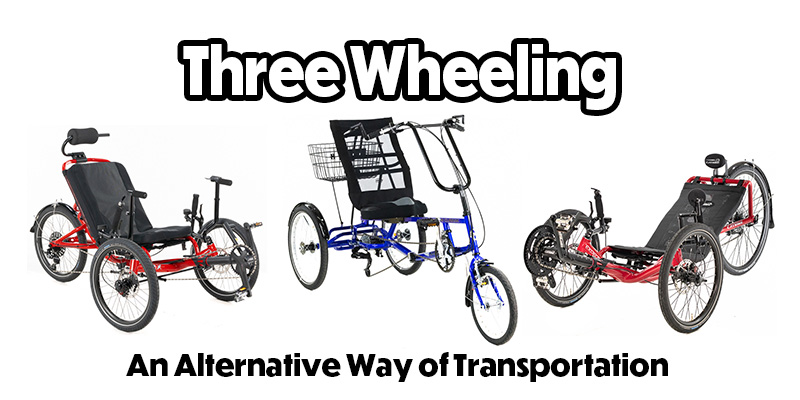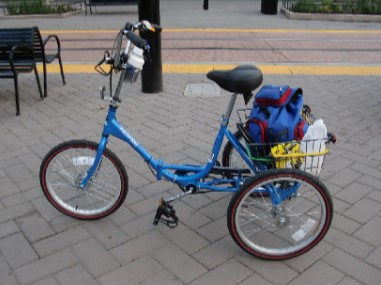

Three-wheeling: An Alternative for Persons with Physical Limitations
Marcia Adams - Published on 03/01/2024
Let me start with a disclaimer
I am not a bicycle or tri-cycle expert. I have no interest in companies that sell bicycles, tri-cycles, or parts. I am a vertically-challenged (balance issues), joint- replaced individual who has walking limitations but enjoys getting out in the fresh air. One of the ways I was able to accomplish this was to use a tri-cycle.
My history with the tri-cycle began about 20 years ago when we purchased a home in Rotterdam, New York. One of the items that was left behind was an adult folding tricycle – one that looked like a blown-up version of what kids rode with the back step piece. Once refurbished by my husband, I rode this tipsy, three-gear bike around town and found that I really did enjoy the sport. I began researching tri-cycles to learn what was out there – other than what I had.
In my mind, there are two types of adult tri-cycles
those that sit and pedal like a two-wheeled bike – I will refer to these as standard type - and those that are referred to as recumbents. The major difference, besides visually, is where your feet are on the pedals. In layman’s terms, in the standard type, your feet and pedals are directly below your knees, and you pedal in an up-and-down, circular motion. In the recumbents version, your feet and pedals are more out in front of you, and you pedal in a horizontal, circular motion. The major difference, in my mind, is the impact on the knees. According to what I have read, the recumbent’s motion uses the same muscles as walking but apply less pressure on the knee joints. Also, the recumbents tend to be lower to the ground, making it easier to get on and off. The other obvious difference is the fact you have three wheels for stability and balance and generally a more chair-like seat.
Generally, most standard types look something like this:

Notice the placement of the pedals and the higher center of gravity. If you are used to riding on two wheels and have only minor balance issues, this type of trike may work for you. There are electric forms of it as well.
Recumbents at least two different types:

Long body (delta): The long bodies have the two wheels in the back of the bike. The handlebars are in the front and it may have various gear combinations. Notice that the pedals are right behind the front wheel, rather than under the seat. In addition, these types of bikes sit lower and have a more chair-like seat. Wheels on this type of bike may or may not all be the same size – the front wheel may be a smaller diameter. The one pictured is not electrified. There are electrified versions of this type of trike.

Tadpole: The tadpole version has two wheels in the front and one in the back. There are no front handlebars; instead, the trike is steered with the two side handles. Brakes, gear shifts, etc. are also on these side handles. Generally, the tires on this type of trike are all the same size. The trike pictured is not electric but electric versions are available.
Now to the nitty-gritty: which type of recumbent is the best for you? The best answer to that question is for you to try them both and then decide. When I first saw a recumbent, the only version I saw was the long body and I purchased it without being aware there were other types out on the market. And it served me very well until I electrified it after-market. The loss of the ability to change gears bothered me only because I wanted to get more exercise out of biking. It was one of the reasons why I wanted to use a bike rather than drive a car somewhere.
I will add that, if you live where there are hills, you do need to consider buying electric, even though they are more costly, unless you are a very strong bicyclist. All three wheelers are heavier than their two-wheeled counterparts; and, combined with the difference in center of gravity, it make them a bit slower and takes more effort to move, particularly uphill I will say, however, a well-geared three-wheeler will keep you moving up a hill albeit slow without dismounting, while on a two-wheeler, you may have to dismount.
My best advice to you, if you are interested in getting back out on the road in other than a car, is to find a dealer who has several trikes on hand so you can try them out. When we purchased our new tadpoles, we decided to work with Utah Trikes (really great people to work with, by the way) because they have one of largest inventories of trikes in the west. After speaking with them on the phone to review what we wanted, we made an appointment so we could do a test drive.
While we were there, and after we decided to purchase, they checked our seat and pedal position, customizing the fit of our purchase to us. Once they were custom built – we wanted some add-on features such as electric and baskets – the trikes were shipped to us fully assembled. It was well worth the four-hour drive! We made the trip a mini-holiday by staying over to enjoy even more the beautiful scenery on the way up to and on the way back from their facility.
If you see my hubby and I meandering through your neighborhood or at the clubhouse, feel free to chat with us. We can share additional information and may even offer you a chance to take a spin.




